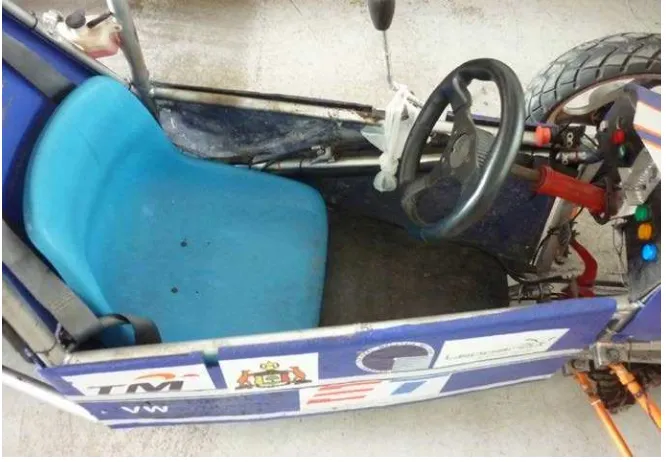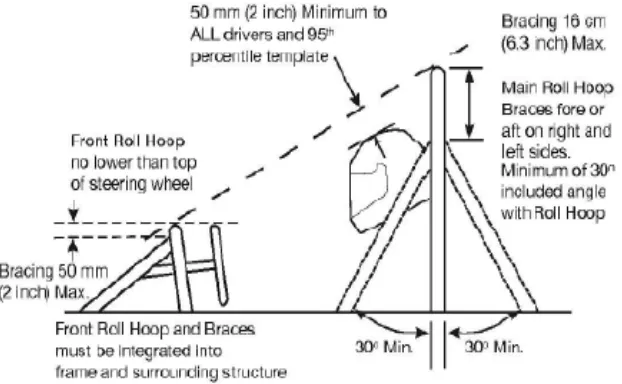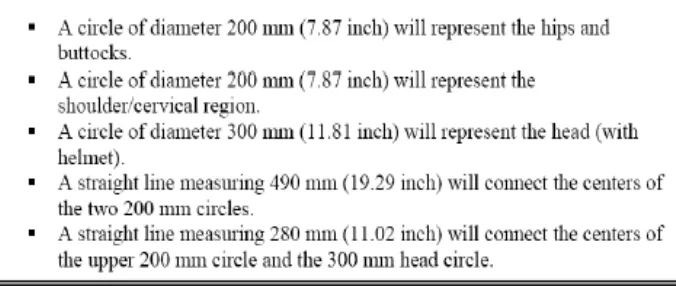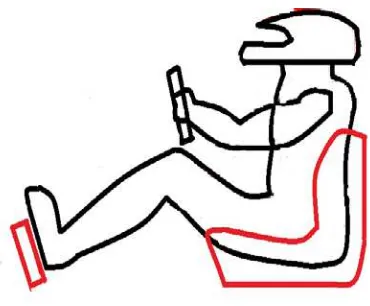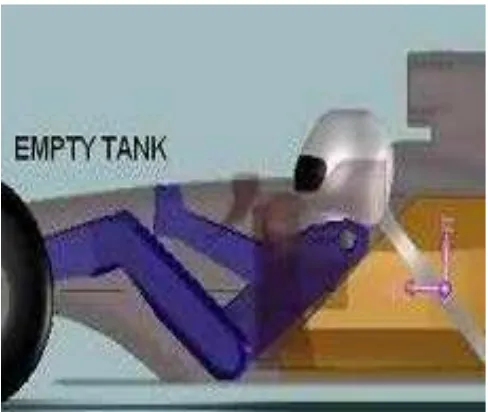SUPERVISOR DECLARATION
“I hereby declare that I have read this thesis and in my opinion this report is sufficient in terms of scope and quality for the award of the degree of
Bachelor of Mechanical Engineering (Design And Innovation)”
Signature : ...
DESIGN AND FABRICATE AN ERGONOMICS COCKPIT FOR SINGLE SEATER FORMULA VARSITY ELECTRIC RACING CAR
JOEHAN ARIFF BIN ISMAIL
This report is presented in
Partial fulfillment of the requirements for the
Bachelor of Mechanical Engineering (Design and Innovation)
FACULTY OF MECHANICAL ENGINEERING UNIVERSITI TEKNIKAL MALAYSIA MELAKA
i
DECLARATION
“I hereby declare that the work in this report is my own except for summaries and quotations which have been duly acknowledged.”
Signature : ...
This thesis is dedicated to my father, En. Ismail Bin Hamzan who taught me that the best kind of knowledge to have is that which is learned for its own sake. It is also
iii
PENGHARGAAN
Pertama sekali saya ingin memanjatkan syukur kepada Allah s.w.t kerana memberi saya kekutan dan keupayaan untuk meneruskan perjuangan menyelesaikan laporan Projek Sarjana Muda ini. Tidak lupa juga saya ingin mengucapkan jutaan terima kasih kepada penyelia projek saya, En. Fadhli Bin Syahrial di atas bimbingan dan dorongan serta tunjuk ajar yang tidak terhingga untuk saya bekerja keras dalam melaksanakan projek saya ini
ACKNOWLEDGEMENT
First of all, I’m totally grateful to Allah s.w.t for giving me strength and ability to fully finish this report for Projek Sarjana Muda. I would like to express my gratitude to my supervisor En. Fadhli Bin Syahrial for his guidance and encouragement for me to work hard to finish this project.
v
ABSTRAK
ABSTRACT
vii
TABLE OF CONTENTS
CHAPTER TITLE PAGE
DECLARATION i
DEDICATION ii
PENGHARGAAN iii
ACKNOWLEDGEMENT iv
ABSTRAK v
ABSTRACT vi
TABLE OF CONTENTS vii
LIST OF TABLES x
LIST OF FIGURES xi
CHAPTER 1 INTRODUCTION 1
1.1 Introduction 1
1.2 Objective 2
1.3 Problem Statements 2
1.4 Scope 3
CHAPTER 2 LITERATURE RIVIEW 4
2.1 Introduction 4
2.2 Competition Rules 5
2.3 Driver Seating Position 6
2.3.1 Arm Positioning 8
2.4 Ergonomics 9
2.4.1 Ergonomics Cockpit 10
2.4.1.2 The steering Wheel Position 11 2.4.1.3 The Gauge Position 12 2.4.1.4 The Pedal, Gear Lever And Kill
Switch 13
2.4.2 Ergonomics Seat 14
2.4.2.1 Headrest 15
2.4.2.2 Backrest 15
2.4.2.3 Seat 16
2.5 Safety in Race Cars 16
2.6 Material 17
CHAPTER 3 METHODOLOGY 19
3.1 Flow Introduction 19
3.2 Gather Information 19
3.3 Quality Function Deployment (QFD) 20
3.3.1 House of Quality 21
3.3.2 Product Design Specification (PDS) 22
3.4 Process of Designing 22
3.5 Literature Review and Finding Information 24
3.6 Selection of Material 24
3.7 CATIA V5 Software Modeling 25
3.8 Fabrication Process (Fiberglass Hand Lay-Up
Process) 25
CHAPTER 4 RESULT AND DISCUSSIONS 27
4.1 Introduction 27
4.2 Design Process 28
4.2.1 Customer Requirements 29
4.2.2 QFD (Quality Function Deployment) 33 4.2.2.1 HOQ (House of Quality) 34 4.2.3 PDS (Product Design Specification) 36
4.2.4 Conceptual Design 37
ix
4.2.5.1 First Conceptual Cockpit Design 39 4.2.5.2 Second Conceptual Cockpit Design 40 4.2.5.3 Third Conceptual Cockpit Design 41 4.2.6 Evaluation and Selection of Concept 42 4.2.7 Evaluating Process of The Concepts
Developed 45
4.28 Final Concept Design 46
4.2.9 Concept Design of The Driver Seat 47
4.2.10 Detail Design 48
4.3 Material Selection 51
4.3.1 Carbon Fiber 51
4.3.2 Fiberglass 52
4.3.3 Material Conclusion 54
4.4 Design Analysis 55
4.4.1 RULA Analysis 55
4.4.2 Eye Vision Analysis 57
4.4.3 Driver Seat Analysis 58
4.5 Fabrication 60
4.5.1 Fabrication Cost 66
4.6 Discussions 67
CHAPTER 5 CONCLUSION AND RECOMMENDATIONS 68
5.1 Conclusion 68
5.2 Recommendations 69
REFERRENCES 71
APPENDIX A 74
LIST OF TABLES
NO. TITLE PAGE
2.1 Types of Fiberglass 18
3.1 Comparison between Fiberglass and Carbon Fibre 24
4.1 HOQ for The Cockpit Design 35
4.2 Application of digital logic method to criteria of cockpit 43 4.3 Weighting Factor for Criteria of Cockpit. 44 4.4 Evaluating Process of The Design Developed 45
4.5 Rating Value 45
4.6 Comparison Between Fiberglass and Carbon Fiber 54 4.7 Total Cost of Raw Material for Fabrication Process 66 4.8 Comparison Between Previous Cockpit and New
xi
LIST OF FIGURES
NO. TITLE PAGE
1.1 Previous Formula Varsity Seat 2
2.1 Illustration of The Clearance Required Above The
Drivers Head. 5
2.2 95th % Percentile Male Dimensions As Depicted In
The 2010 Rules. 6
2.3 Previous Driver Sitting Position on Utem Formula
Varsity Car 7
2.4 Sitting Position on Street Car 7
2.5 Laying Back Sitting Position 8
2.6 The 10 and 2 O’clock Hand Positioning 9
2.7 Human Machine System 10
2.8 Formula One Driver Sight 11
2.9 The Distance Of Steering Wheel From The Driver. 12
2.10 RPM LED’s Indicator (In Circle) 13
2.11 The Angle Of The Leg With Disengaged Pedals. 14
2.12 Example of Bucket Seat Types. 14
2.13 The Rearward Inclined Backrest Position Requires More
Strain To Sit And To Stand. 15
2.14 The Crash Safety System 17
3.1 Method to Gather Information Of The Previous Product 20 3.2 QFD Product Planning House (House of Quality) 21 3.3 Complete Configuration of House Of Quality 22
4.1 Total Design Method 28
4.2 View of The Previous Cockpit 38
4.3 Side View of The First Conceptual Cockpit Design 39 4.4 Front View of The First Conceptual Cockpit Design 39 4.5 Side View of The Second Conceptual Cockpit Design 40 4.6 Front View of The Second Conceptual Cockpit Design 40 4.7 Side View of The Third Conceptual Cockpit Design 41 4.8 Front View of The Third Conceptual Cockpit Design 41 4.9 Side View of The Final Conceptual Cockpit Design 46 4.10 Front View of The Final Conceptual Cockpit Design 46 4.11 Perspective View of The Conceptual Driver’s Seat Design 47
4.12 Side View of The Detail Design Cockpit 48
4.13 Front View of The Detail Design Cockpit 49 4.14 Perspective View of The Detail Design Seat 50
4.15 Side View of The Detail Design Seat 50
4.16 Carbon Fiber Ply 52
4.17 Fiberglass mat types 53
4.18 Hardener (left) and Resin (right) 53
4.19 RULA Analysis for Manikin 56
4.20 Data for The RULA Analysis of Manikin 56
4.21 The Driver Vision While Sitting in The Cockpit 58 4.22 Displacement Analysis for The Driver’s Seat 59
xiii
4.24 Fiberglass Mat Type 60
4.25 Hardener (left) and Resin (right) 61
4.26 Wire Mesh 61
4.27 Mould Preparation using The Wire Mesh 62
4.28 Complete Mould 62
4.29 Resin and Hardener Mixing Process 63
4.30 Fiberglass Lay-up Process 63
4.31 Product Trimming Process 64
4.32 Final Product after Trimming Process 64
4.33 Installation Process of Parts in The Cockpit 65
CHAPTER I
INTRODUCTION
1.1 INTRODUCTION
Cockpit is the important things in a race car. In the cockpit, there are located steering wheel, driver seat, throttle and brake pedal and gauges. It is like a control room to the car. The driver can know the car condition when driving. The gauge will let the driver know the car conditioning. It is important to design a cockpit that can comfort the driver. Improper design of the cockpit can make the driver difficult and feel uncomfortable. Also can affect the driver driving performance.
Comfort in the human-machine interface and the mental aspects of the product or service is a primary ergonomic design concern. Comfort is one of the greatest aspects of a design’s effectiveness and is a primary ergonomics design concern. The utility of an item is the only true measure of the quality of its design. The job of any designer is to find innovative ways to increase the utility of a product. Physical comfort while using an item increases its utility. The mental aspect of comfort in the human-machine interface is found in feedback. The look, feel, use and durability of a product will make a mental determination about a product or service. Better ergonomics means better quality which means it will be more comfortable with the value of the item.
2
[image:17.595.153.486.133.364.2]will need to be geared towards simplicity and strength but fulfill the ergonomics aspects. Figure 1.1 show the previous cockpit of the UTeM Formula Varsity car.
Figure 1.1 Previous Formula Varsity cockpit.
1.2 OBJECTIVE
For this project, it has three major objectives. The objectives are:
i. To design an ergonomics seat for single seater Formula Varsity electric racing car using CAD.
ii. To analyze the strength and comfortability of the ergonomics seat.
iii. To fabricate an ergonomic seat for single seater Formula Varsity electric racing car.
1.3 PROBLEM STATEMENT
be considered are the seat design and angle of the driver seat, the position of the steering wheel and the driver bottom part position / leg. Therefore, the performance of the driver will improve while racing.
Known as, comfortability and strength of the seat is the main point that affects the driver performance. So, the main purpose of this project is to design and develop a seat that can support the back of the driver also the tight to make the driver feel comfort during race. The fully support seat will hold the driver especially when taking a corner.
This project carried out all of the necessary background research required to sustain an accurate database of design criteria. Design criteria then allowed the design process and methodology to be derived and to allow for smooth construction of an efficient and effective seat. Once construction of the seat was completed, analyses were conducted to investigate the effects of working loads on the seat.
1.4 SCOPE
There are several scopes for this project. The scopes for this project are: i. To produce detail and 3D design of the seat using CATIA.
ii. Study the requirements of the ergonomics seat for single seater FV electric racing car
iii. Study and find the best design reliable for the driver of the electric car. iv. Study the suitable material used in fabricating an ergonomics seat.
CHAPTER II
LITERATURE REVIEW
2.1 INTRODUCTION
The Formula Varsity is a student competition in Malaysia. The competition such as like Formula SAE give impression for engineering student to gain experience in the design, manufacture and test of the vehicle. The concept of this event also came from SAE competition held in United Kingdom, America and Canada. The objectives of such event are to expose student to practical work, to give students to apply theories into practical and to develop new talent of students in automotive industry.
5
2.2 COMPETITION RULES
Adhering to the rules that govern the chassis for the competition is a pivotal part of the research. If one small sub-section rule is not followed by the chassis, it will disqualify the whole car from the competition.
[image:21.595.171.482.392.584.2]Within the competition rules that are solely for the chassis, when attempting to insure all the rules are met, it is easy to miss small details when the rules are set out in this form. So, to simplify this process a summary of the rules was created and broken down into all individual areas of the chassis layout. These areas were, Main Hoop, Front Hoop, Bulkhead, Main Hoop Bracing, Front Hoop Bracing, Bulkhead Support, Other Bracing and Side Impact Members. The design of the seat will determine the seating position of the driver it will affect the height of the roll cage and indirectly, will affect the chassis design.
Figure 2.2 95th % percentile male dimensions as depicted in the 2010 rules. (http://formulavarsity.utem.edu.my, 2010)
2.3 DRIVER SEATING POSITION
7
[image:23.595.214.399.294.447.2]pedals also require little more than a flexing of the ankle to go from 0-100% depression. The driver also has to make sure that his butt sits all the way to the back of the seat where exactly the base and back of the seat are joined. A more upright stance can be enjoyed by the driver and the natural curvature of the spine would be maintained and this would actually reduce the stress on the ligaments of the spine. A slouched position result in restricted head rotational movements and this can actually reduce the line of vision for the driver. Moreover, backward bending of the head becomes almost impossible when one is slouched forward and such a posture can even result in a whiplash injury from a slight rear end impact.
Figure 2.3 Previous driver sitting position on UTeM Formula Varsity car.
Figure 2.4 Sitting position on street car.
[image:23.595.217.421.532.703.2]Figure 2.5 Laying back sitting position (http://www.atlasf1.com/2000/nov29/gray.html)
